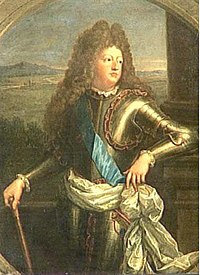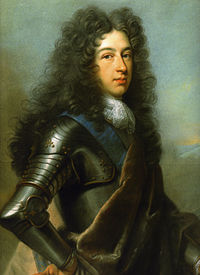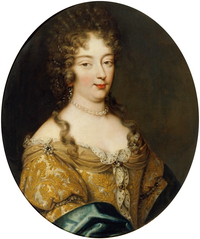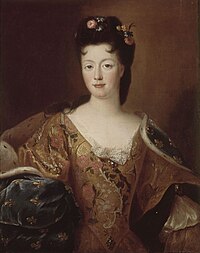Prince du sang















A Prince of the Blood was a person who was legitimately descended in the male line from the monarch of a country. In France, the rank of prince du Sang played a major role in determining court precedence during the Ancien Régime, from the reign of King Henry IV of France onward to the reign of his great-great-great-great-great grandson, Charles X. During this time period, a prince du Sang or a princesse du Sang had to be a legitimate member of the reigning House of Bourbon. In some European monarchies, but especially in the kingdom of France, this appellation was a specific rank in its own right, of a more restricted use than other titles.
Styles
The notion of prince du sang is restricted to agnatic royal descendants. Depending on national tradition, the appellation may have restricted scope or not, often no further than one or two generations after the monarch and / or the line of succession, or it may be allowed to run into very high numbers, as is often the case in oriental dynasties.
In France, examples of this are:
Monsieur le Dauphin
This was a form of address to the Dauphin of France, or the heir to the throne. The Dauphin de France, strictly-speaking Dauphin de Viennois, was the title used for the heir apparent to the throne of France from 1350 to 1791 and then from 1824 to 1830.
- Louis de France was usually not referred to by this style as he was referred to at court by two other informal styles, those of Monseigneur and Le Grand Dauphin.
- His eldest son who became the dauphin after his death was informally known as Le Petit Dauphin.
Madame la Dauphine
This was the style of the wife of the Dauphin. Some famous examples of holders of the honorific till death were:
- Maria Anna Christine Victoria von Wittelsbach; also called Dauphine Victoire. She was the first wife of Monseigneur and grandmother of Louis XV
- Marie-Adélaïde de Savoie; she was wife of the Le Petit Dauphin and mother of Louis XV. She was also a grand-daughter of Madame, the first wife of Monsieur.
- Marie-Thérèse-Antoinette-Raphaëlle de Bourbon; she was the first wife of the only son of Louis XV and held the style till her death in 1748 at age twenty-one.
- Maria Josepha Carolina of Saxony; she was the second wife of the only son of Louis XV and was later the mother of Louis XVI, Louis VIII and Charles X of France.
- Maria Antonia of Austria; before her husband, Louis XVI, succeeded to the throne, Marie Antoinette was the Dauphine.
- Marie-Thérèse-Charlotte de France; known as a child as Madame Royale, she became the last Dauphine of France when her father-in-law succeeded to the throne in 1830.
Madame Royale
This was the style of the eldest surviving daughter of the King. Particular holders of this honorific were:
- Élisabeth de France - the eldest daughter of King Henry IV of France and his second wife, Queen Marie de' Medici. In 1615, Élisabeth was married to the future king, Philip IV of Spain. On her death in 1644, the style reverted to her younger sister, Christine de France.
- Christine Marie de France - the second daughter of King Henry IV and Marie de' Medici. In 1619, Christine was married to Victor Amadeus I, Duke of Savoy. She assumed the style of Madame Royale upon the death of her older sister, the Queen of Spain.
- Marie-Thérèse de France, the eldest daughter of Louis XIV and his Queen Maria Theresa of Spain. She died at the age of 5 in 1672. The title was used unofficially by her Orléans cousins before their marriages.
- Louise-Élisabeth de France - the eldest daughter of King Louis XV and his wife, Queen Maria Leszczyńska. As a twin, Louise-Élisabeth rarely if ever used this title. She prefered being called Madame Première, to distinguish herself from her younger twin sister, Henriette-Anne de France, who was referred to by the court as Madame Seconde.
- Marie-Thérèse Charlotte de France - probably the most famous recipient of the honorific. She was the eldest daughter of King Louis XVI and his wife, Queen Marie Antoinette.
This style was occasionally also used by the most senoir unmarried princess at the French Court when the King had no living daughter. It was briefly used by the eldest niece of Louis XIV, Marie Louise d'Orléans, later known as just Mademoiselle. After her marriage to the King of Spain in 1679, the styles was assumed briefly by her younger sister, Anne Marie d'Orléans, before she married Victor Amadeus II of Sardinia later King of Sardinia and King of Sicily. Between the death of Queen Henrietta Maria of England, the youngest daughter of King Henry IV, in 1669 and the birth of Louise-Élisabeth de France, the eldest daughter of King Louis XV in 1727, there were no daughters of the King who survived childhood.
Monsieur
This honorific was the style of the oldest living brother of the King. Among those who held this style were:
- Charles, duc d'Orléans - (1559-1560), younger brother of François II and became known as Monsieur at the beginning of the reign of François II. He later was King of France as Charles IX from 1560-1574;
- Henri, duc d'Anjou - (1560-1574), younger brother of Francois II and Charles IX and became known as Monsieur at the beginning of the reign of Charles IX. He later was King of France as Henri III from 1574-1589;
- François, duc d'Anjou - (1574-1584), youngest brother of François II, Charles IX and Henri III and became known as Monsieur at the beginning of the reign of Henri III;
- Gaston, duc d'Orléans - (1610-1660), younger brother of Louis XIII and became known as Monsieur at the beginning of the reign of Louis XIII. He held the style till he died in 1660;
- When his brother Louis XII died in 1643, his nephew Philippe, duc d'Anjou was known as Le Petit Monsieur and Gaston as Le Grand Monsieur.
- Philippe, duc d'Orléans - (1640-1701), was the younger brother of Louis XIV and was known as Le Petit Monsieur while his uncle was alive. He became known as Monsieur in 1660 after his uncle, Gaston, died and held the style till his own death in 1701. He was the founder of the House of Orléans;
- Louis Stanislas, comte de Provence - (1774-1793), younger brother of Louis XVI and became known as Monsieur at the beginning of the reign of Louis XVI. He later was King of France as Louis XVIII from 1814-1824 ;
- Charles Philippe, comte d'Artois - (1795-1824) was the youngest brother of Louis XVI and Louis XVIII and became known as Monsieur at the beginning of the reign of Louis XVIII. He later was King of France as Charles X from 1824-1830.
Madame
This was the style of the wife of Monsieur. The most famous examples of this were:
- Henrietta Anne Stuart - the first wife of King Louis XIV's younger brother, Philippe I, duc d'Orléans (Monsieur).
- Elizabeth Charlotte, Princess Palatine - the second wife of Philippe I, duc d'Orléans (Monsieur).
Monsieur le Prince
This was the style of the First Prince of the Blood. The rank of First Prince of the Blood (French: Premier Prince du Sang) in France belonged to the most senior male member of the royal house who was not a brother of the King or a Fils de France. It carried with it various legal privileges, including the right to a household paid out of state revenues. The rank was held for life - the birth of a new, more senior prince who qualified for the position did not deprive the current holder of his rank. The style of Monsieur le Prince was held for over a century by the Princes de Condé. Later it passed to the House of Orléans who became the First Princes in 1709
First Princes of the Blood, 1465-1830
- 1. Louis II, duc d'Orléans 1465-1498;
- 2. François, comte d'Angoulême 1498-1515.
House of Bourbon-La Marche
- 3. Charles IV, duc d'Alençon 1515-1525;
- 4. Charles III, duc de Bourbon should had been first prince but he was banned from position for treason 1525-1527;
- 5. Charles IV de Bourbon, duc de Vendôme 1527-1537;
- 6. Antoine de Bourbon, duc de Vendôme, later King of Navarre 1537-1562.
- 7. Henri III, King of Navarre 1562-1589;
- 8. Henri II de Bourbon, prince de Condé 1589-1646;
- 9. Louis II de Bourbon, prince de Condé 1646-1686;
- 10. Henri III de Bourbon, prince de Condé 1686-1709.
- 11. Philippe II, duc d'Orléans 1709-1723, was entitled to the style, but did not use it;
- 12. Louis, duc d'Orléans 1723-1752;
- 13. Louis Philippe I, duc d'Orléans 1752-1785;
- 14. Louis Philippe II, duc d'Orléans 1785-1793;
- 15. Louis Philippe III, duc d'Orléans 1814-1830, who later ruled as King Louis Philippe of the French.
Madame la Princesse
This style was held by the wife of Monsieur le Prince.
Monsieur le Duc
This style was used for the eldest son of the Prince of Condé. Originally, the eldest son was given the title of Duke of Enghien, but that changed later with the eldest son being given the title of Duke of Bourbon, and his eldest son (the eldest grandson of the Prince of Condé in the male line) being given the title of Duke of Enghien.
- 1. 1689-1709 : Henri I, duc d'Enghien (1643-1709);
- 2. 1709-1710 : Louis I, duc d'Enghien (1668-1710);
- 3. 1710-1740 : Louis II Henri, duc d'Enghien (1692-1740);
- 4. 1740-1818 : Louis III Joseph, duc d'Enghien (1736-1818);
- 5. 1818-1830 : Louis IV Henri, duc d'Enghien (1756-1830).
Madame la Duchesse
This style was used for the wife of Monsieur le Duc. The most famous holder of this honorific was:
- Louise-Françoise de Bourbon - The illegitimate daughter of Louis XIV and his most famous mistress, Madame de Montespan, she was married in May 1685, to Louis III, Prince of Condé, then known by the courtesy title of Duc de Bourbon. Since his style at court was Monsieur le Duc because he was the Duc de Bourbon, she became known as Madame la Duchesse.
Monsieur le Comte
This address was used by the holder of the title of Count of Soissons. The Counts of Soissons, like the Princes of Conti, descended from the Princes of Condé. The line started in 1566 when the Soissons title was given to Charles de Bourbon-Condé, the second son of Louis I de Bourbon, prince de Condé, the first Prince of Condé. In all, the first Prince had three sons:
- 1. Henri de Bourbon-Condé, second Prince of Condé;
- 2. Charles de Bourbon-Condé, first Count of Soissons and the founder of the House of Bourbon-Soissons;
- 3. François de Bourbon-Condé, first Prince of Conti but the Conti title lapsed upon his death in 1614 without legitimate heirs. It was later revived in 1629 for Armand de Bourbon, prince de Conti, the second son of Henry II, Prince of Condé.
The Soissons title was acquired by the first Prince of Condé in 1557 and was held by his descendents for two more generations:
- 1. Charles de Bourbon-Condé, 1st comte de Soissons
- 2. Louis de Bourbon-Condé, 2nd comte de Soissons
The 2nd comte de Soissons died without an heir, so the Soissons title passed to his younger sister, Marie de Bourbon-Condé. She was known as Madame la comtesse de Soissons. On her death, the title passed first to her second son, Joseph-Emmanuel of Savoy-Carignan (1631-1656), and then to her third son, Prince Eugène-Maurice of Savoy-Carignan. He married Olympe Mancini, niece of Cardinal Mazarin. She was known as Madame la comtesse de Soissons like her mother-in-law. On his death, the title went to his eldest son, Prince Louis Thomas of Savoy-Carignan, who was the older brother of the famous Austrian general, François-Eugène, Prince of Savoy-Carignan.
Madame la Comtesse
This style was used by the wife of Monsieur le Comte. The best example of this is:
- 1. Olympe Mancini.
Mademoiselle
This style was held by the eldest daughter of Monsieur and his wife, Madame. The best example of this was Marie Louise d'Orléans, later the wife of King Charles II of Spain. She was the eldest daughter of King Louis XIV's younger brother, Monsieur.
Younger daughters of Monsieur were named after one of Monsieur's inherited fiefdoms. An example of this was Mademoiselle de Chartres, the third surviving daughter of Louis XIV's younger brother, Monsieur.
La Grande Mademoiselle
This style was specifically created for the daughter of Gaston, Duke of Orléans. This daughter, Anne Marie Louise d'Orléans, duchesse de Montpensier, was called La Grande Mademoiselle at court in order to distinguish her from her younger cousin, Marie Louise d'Orléans, called Mademoiselle, the daughter of La Grande Mademoiselle's first cousin, Monsieur.
Monsieur le Grand
This was the title of the Le Grand Écuyer de France or the Grand Squire of France. He was in charge of the royal stables, the transport of the king and his ceremonial entourage (heralds, men of arms, musicians, etc.). As well as the superintendence of the royal stables, he had that of the retinue of the sovereign, also the charge of the funds set aside for the religious functions of the court, coronations, etc. From 1643 to the French Revolution, the Grand Écuyer was chosen from the House of Lorraine
A list of people who would have to be addressed by this is as follows:
- 1. 1526-1546: Jacques de Genouillac (Galiot de Genouillac), seigneur d'Assier
- 2. 1595-1611: Roger de Saint-Lary, duc de Bellegarde
- 3. 1611-1621: César-Auguste de Saint-Lary, baron de Termes
- 4. 1621-1639: Roger de Saint-Lary, duc de Bellegarde
- 5. 1639-1643: Henri de Coëffier de Ruzé d'Effiat, marquis de Cinq-Mars
- 6. 1643-1658: Henri de Lorraine, comte d'Harcourt
- 7. 1666-1677: Louis de Lorraine, comte d'Armagnac
- 8. 1677-1718: Henri de Lorraine, comte de Brionne
- 9. 1718-1752: Charles de Lorraine, comte d'Armagnac ("le prince Charles")
- 10.1752-1761: Louis-Charles de Lorraine, comte de Brionne
- 11.1761-1790: Charles-Eugène de Lorraine, prince de Lambesc
Monsieur le Premier
This was the style of the person in charge of the Kings Horses or the petite écurie du roi. He was second in command to Monsieur le Grand and was also in charge of the Squires of France, the pages of the court, the footmen at the various palaces of the Royal Family, the Carriages of the family and the Porter Chairs.
He was also in charge of the Treasury of the Royal Stables. This post was, from 1645, a hereditary post in the House of Beringhem (a family from the Netherlands). It was first aquired by Henri Canaille, marquis de Beringhem.
Other
Madame la Princesse Douarière
In order to tell the wives of the Conti bothers appart after their deaths, the widows were given the name of Douarière or dowager and a number corresponding to when they lost their husband. After being widowed their full style would be Madame la Princesse de Conti 'number' Douarière. By 1727 there were 3 widowed Princesses. They were:
- Marie Anne de Bourbon illegitimate daugter of Louis XIV and Louise Françoise de La Baume Le Blanc.
She was the wife of Louis Armand I, Prince of Conti. She was known as Madame la Princesse de Conti Première Douarière as she was the first to be widowed in 1685. The title went to his brother.
- Marie-Thérèse de Bourbon-Condé wife of François Louis, Prince of Conti and known as ''Madame la Princesse de Conti Seconde Douarière after loosing her husband in 1709.
- Louise-Élisabeth de Bourbon-Condé wife of Louis Armand II de Bourbon, prince de Conti. She was known as Madame la Princesse de Conti Troisième/Dernière Douarière.
She was the last to be widowed and was also the daughter of Madame la Duchesse and Monsieur le Duc.
Note: this was not a title by right but was a means of determining who held the title of Princesse de Conti at a specific time
Painting of the Bourbons

See Also
 |
| Ancien Régime |
|---|
| Structure |
- Dauphin
- The eldest son of the King and heir to the throne. The wife of the Dauphin would be called the Dauphine.
- Madame Royale
- The eldest daughter of the King.
- Fils de France
- A son of the King. A daughter of the King would be called a Fille de France.
- Petit-fils de France
- A grandson of of the King in the male line. A grand-daughter of the King in the male line would called a Petite-Fille de France.
- Monsieur
- The eldest living brother of the King.
- Madame
- The wife of the eldest living brother of the King.
- First Prince of the Blood
- The eldest male relative of the King in the male line who was not a brother or descendent of the King.
- Great Officers of the Crown of France
- Grand Squire of France - see for Grand Écuyer de France
